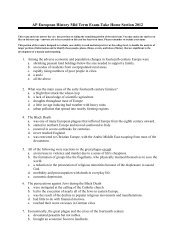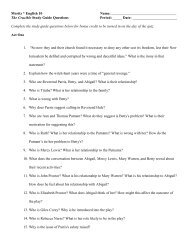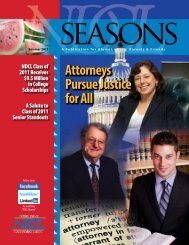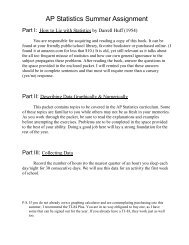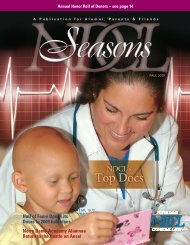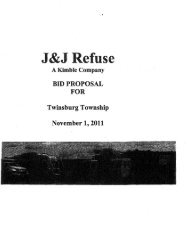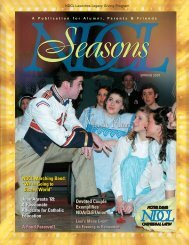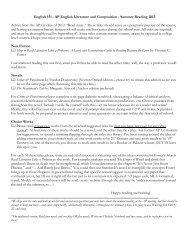ALLERGY ACTION PLAN - eSchoolView
ALLERGY ACTION PLAN - eSchoolView
ALLERGY ACTION PLAN - eSchoolView
Create successful ePaper yourself
Turn your PDF publications into a flip-book with our unique Google optimized e-Paper software.
<strong>ALLERGY</strong> <strong>ACTION</strong> <strong>PLAN</strong>USE 1 FORM PER CHILD FOR EACH ALLERGENStudent _______________________________________________________________________DOB ______________________________ Teacher ________________________________Allergy to _____________________________________________________________________Asthmatic? Yes* No *Higher risk for severe reactionSTEP 1 - TREATMENTSEND STUDENT TO HEALTH OFFICE ACCOMPANIED BY RESPONSIBLE PERSON.The severity of symptoms can quickly change. †Potentially life threatening.SymptomsGive checked Medication****To be determined by physician authorizing treatment If a student has been exposed to/ingested an allergen but has NO symptoms: Epinephrine Antihistamine Mouth Itching, tingling, or swelling of lips, tongue, mouth: Epinephrine Antihistamine Skin Hives, itchy rash, swelling of the face or extremities: Epinephrine Antihistamine Gut Nausea, abdominal cramps, vomiting, diarrhea: Epinephrine Antihistamine Throat† Tightening of throat, hoarseness, hacking cough: Epinephrine Antihistamine Lung† Shortness of breath, repetitive coughing, wheezing: Epinephrine Antihistamine Heart† Thready pulse, low blood pressure, fainting, pale, blueness: Epinephrine Antihistamine Other† ________________________________________________________ : Epinephrine Antihistamine If reaction is progressing, (several of the above areas affected), give: Epinephrine AntihistamineDOSAGE START DATE ______________________ END DATE ________________________Epinephrine: Inject intramuscularly. See reverse side for instructions.Important; Asthma inhalers and/or antihistamines EpiPen® cannot be depended upon to replace EpiPen® Jr. epinephrine in anaphylaxis. Twinject 0.3mg Twinject 0.15mgAntihistamine: Give _________________________________________________________________________________________antihistamine/dose/routeOther: Give ________________________________________________________________________________________________medication/dose/routeSpecial Instructions (for health care provider to complete): ____________________________________________________________________________________________________________________________________________________________________STEP 2 - EMERGENCY CALLSPARAMEDICS MUST BE CALLED IF EPIPEN OR TWINJECT IS GIVEN. EPIPEN OR TWINJECT ONLY LAST 15-20MINUTES.1. Call 911 (or Rescue Squad ___________________________ ). State that an anaphylactic reaction has been treated, type oftreatment given (i.e., EpiPen or Twinject) and that additional epinephrine may be needed.2. Parents __________________________________________________________ Tel ________________________________3. Physician _____________________________________________________ Tel ________________________________AllergiesPage 10 – 4/30/2007Proprietary information of PSI Affiliates, Inc. May not be copied without consent.
EMERGENCY CONTACTS1. ________________________________________________________ Relation:___________________________Tel:2. ________________________________________________________ Relation:___________________________Tel:3. ________________________________________________________ Relation:___________________________Tel:TRAINED STAFF MEMBERS1. ________________________________________________________ Room:_____________________________2. ________________________________________________________ Room:_____________________________For children with multiple food allergies, use one form for each food.EVEN IF PARENT/GUARDIAN CANNOT BE REACHED, DO NOT HESITATE TO MEDICATE OR TAKECHILD TO MEDICAL FACILITY!Parent/Guardian Signature_______________________________________________Physician Signature____________________________________________________(required)Date _______________________________Date _______________________________AllergiesPage 2 – 4/30/2007Proprietary information of PSI Affiliates, Inc. May not be copied without consent.
AllergiesPage 3 – 4/30/2007Proprietary information of PSI Affiliates, Inc. May not be copied without consent.
AllergiesPage 4 – 4/30/2007Proprietary information of PSI Affiliates, Inc. May not be copied without consent.
LETTER TO PARENTSALLERGIC RE<strong>ACTION</strong>STO:FROM:DATE:SUBJECT:ParentsClinic Staff_________________________Allergic ReactionsThe health care forms you submitted for __________________________________________________________indicate he/she has an allergic reaction to__________________________________________________________ .The school would appreciate the following:1. A signed letter from your doctor with instructions the school is to follow in the event that yourchild experiences an allergic reaction while at school. You may elect to fill out and return theenclosed <strong>ALLERGY</strong> <strong>ACTION</strong> <strong>PLAN</strong>.2. Two epinephrine kits, if prescribed (EpiPen or Twinject), or other medication to be used if anallergic reaction occurs.Your speedy attention to the above matter is appreciated. We would welcome an opportunity to meet with you todiscuss your child’s allergy and how we can implement a personalized health management plan. Please contact meat ________________________________________________________________________________________ .EnclosureAllergiesPage 5 – 4/30/2007Proprietary information of PSI Affiliates, Inc. May not be copied without consent.
BEE AND WASP STINGSTHREE KINDS OF RE<strong>ACTION</strong>SStings may produce a needle-prick sensation and a little swelling. In a few cases, an allergic reaction may set in.However, it usually takes repeated stings before a severe reaction occurs. Across the country, some 40 people willdie this year from allergic reactions. Countless others will suffer from a range of discomforts:NORMALReactionIMMEDIATEALLERGICRE<strong>ACTION</strong>DELAYEDRE<strong>ACTION</strong>ALLERGIC— Immediate pain— Swelling at the sting area— Onset in 2-3 minutes— Hives over whole body— Hacking cough— Facial swelling— Anxiety— Wheezing— Nausea and vomiting— Onset 10-14 days after sting— Fever— Discomfort— Hives— Headache— ItchingAllergiesPage 6 – 4/30/2007Proprietary information of PSI Affiliates, Inc. May not be copied without consent.
• Remove stinger with a horizontal scraping motion using fingernail or card; do not squeeze or pull or you’llrelease more venom.• Clean with soap and water.• Apply ice compresses.• Call child’s physician immediately or take child to nearest emergency department.• If child is known to be hypersensitive, check with the child’s doctor about prescribing an emergency stingtreatment kit to keep at home.Call child’s physician.AllergiesPage 7 – 4/30/2007Proprietary information of PSI Affiliates, Inc. May not be copied without consent.
POISON IVY/OAKCONTACT DERMATITISPHYSICAL FINDINGS1. Reaction begins 1 - 4 days after exposure.2. Contents of blisters and weepy skin cannot cause rash in another individual or even in another location onpatient.3. Early: Itching, redness, small papules and vesicles.4. Late: Increase of all early signs plus larger blisters and generalized weeping of skin.5. Healing: Dryness, crusting and gradual shedding of crusts and scabs. May take 2 - 3 weeks.6. Most common on hands, forearms, and face.7. No fever.MANAGEMENT1. Wash thoroughly after exposure (usually too late when discovered at school).2. Try to prevent scratching. Loose dressings may help.3. Refer to physician if severe or infected.FOLLOW-UP1. Observe for infection and treat as needed.2. Warn against re-exposure, as the reaction will be worse next time.3. Educate about appearance of plant.AllergiesPage 8 – 4/30/2007Proprietary information of PSI Affiliates, Inc. May not be copied without consent.
ODH SCHOOL NURSE BULLETIN BOARDNEW EPI-PEN LAWEffective March 23, 2007, students in Ohio schools will be permitted to carry and use an epinephrine autoinjectorwith the permission of the prescriber of the medication and the parent/guardian. The new law will be numbered,Ohio Revised Code (ORC) 3313.718 and applies to any activity, event, or program sponsored by the student’sschool or in which the school participates. This new law is very similar to the asthma inhaler law with a fewsignificant differences. The new Epi-Pen law requires:1) acknowledgment that the prescriber has determined that the student is capable of possessing and using theautoinjector appropriately and has provided the student with training in the proper use of the autoinjector;2) the school has received a backup dose of the anaphylaxis medication; and3) whenever an autoinjector is used, a school employee shall immediately request assistance from anemergency medical service provider (e.g., call 9-1-1).AN ACTTo amend sections 3313.64 and 3314.03 and to enact sections 3313.718 and 3314.141 of the Revised Code withrespect to use of epinephrine medication in school districts, community schools, and chartered non-public schools.SEC 3313.718(A) As used in this section “prescriber” has the same meaning as in section 4729.01 of the Revised Code(B) Notwithstanding section 3313.713 of the Revised Code or any policy adopted under that section, a student of aschool operated by a city, local, exempted village or joint vocational school district or a student of a charterednonpublic school may possess and use an epinephrine autoinjector to treat anaphylaxis, if all of the followingconditions are satisfied:(1) The student has the written approval of the prescriber of the autoinjector and if the student is a minor, thewritten approval of the parent, guardian, or other person having care or charge of the student. Theprescriber’s written approval shall include at least all of the following information:(a) The student’s name and address.(b) The names and dose of the medication contained in the autoinjector.(c) The date the administration of the medication is to begin.(d) The date, if known, that the administration of the medication is to cease.(e) Acknowledgment that the prescriber has determined that the student is capable of possessing and usingthe autoinjector appropriately and has provided the student with training in the proper use of theautoinjector.AllergiesPage 9 – 4/30/2007Proprietary information of PSI Affiliates, Inc. May not be copied without consent.
(f) Circumstances in which the autoinjector should be used.(g) Written instructions that outline procedures school employees should follow in the event that thestudent is unable to administer the anaphylaxis medication or the medication does not produce theexpected relief from the student’ s anaphylaxis.(h) Any severe adverse reactions that may occur to the child using the autoinjector that should be reportedto the prescriber.(i) Any severe adverse reactions that may occur to another child, for whom the autoinjector is notprescribed, should such a child receive a dose of the medication.(j) At least one emergency telephone number for contacting the prescriber in an emergency.(k) At least one emergency telephone number for contacting the parent guardian or other person having careor charge of the student in an emergency.(2) Any other special instructions from the prescriber.(3) The school principal or if a school nurse is assigned to the student’s school building, the school nurse hasreceived copies of the written approvals required by division (B)(1) of this section.(4) The school principal, or, if a school nurse is assigned to the student’s school building, the school nursehas received a backup dose of the anaphylaxis medication from the parent, guardian, or other person havingcare or charge of the student or, if the student is not a minor, from the student.If these conditions are satisfied, the student may possess and use the autoinjector at school or at anyactivity, event, or program sponsored by or in which the students school is a participant.(C) Whenever a student uses an autoinjector at school or at any activity, event or program sponsored by or in whichthe student’s school is a participant or whenever a school employee administers anaphylaxis medication to astudent at such times, a school employee shall immediately request assistance from an emergency medicalservice provider.(D)(1)A school district, member of a school district board of education, or school district employee is not liablein damages in a civil action for injury, death, or loss to person or property allegedly arising from a districtemployee’s prohibiting a student from using an autoinjector because of the employee’s good faith beliefthat the conditions of division (B) of this section had not been satisfied A school district, member of aschool district board of education, or school district employee is not liable in damages in a civil action forinjury, death, or loss to person or property allegedly arising from a district employee’s permitting a studentto use an autoinjector because of the employee’s good faith belief that the conditions of division (B) of thissection had been satisfied. Furthermore, when a school district is required by this section to permit astudent to possess and use an autoinjector because the conditions of division (B) of this section have beensatisfied the school district, any member of the school district board of education, or any school districtemployee is not liable in damages in a civil action for injury, death, or loss to person or property allegedlyarising from the use of the autoinjector by a student for whom it was not prescribed.This section does not eliminate limit or reduce any other immunity or defense that a school district,member of a school district board of education, or school district employee may be entitled to underChapter 2744 or any other provision of the Revised Code or under the common law of this state.AllergiesPage 10 – 4/30/2007Proprietary information of PSI Affiliates, Inc. May not be copied without consent.
(2) A chartered nonpublic school or any officer, director, or employee of the school is not liable in damages ina civil action for injury, death or loss to person or property allegedly arising from a school employee’sprohibiting a student from using an autoinjector because of the employee’s good faith belief that theconditions of division (B) of this section had not been satisfied A chartered nonpublic school or any officer,director, or employee of the school is not liable in damages in a civil action for injury, death, or loss toperson or property allegedly arising from a school employee’s permitting a student to use an autoinjectorbecause of the employee’s good faith belief that the conditions of division (B) of this section had beensatisfied. Furthermore, when a chartered nonpublic school is required by this section to permit a student topossess and use an autoinjector because the conditions of division (B) of this section have been satisfied,the chartered nonpublic school or any officer, director, or employee of the school is not liable in damages ina civil action for injury, death, or loss to person or property allegedly arising from the use of theautoinjector by a student for whom it was not prescribed.AllergiesPage 11 – 4/30/2007Proprietary information of PSI Affiliates, Inc. May not be copied without consent.



